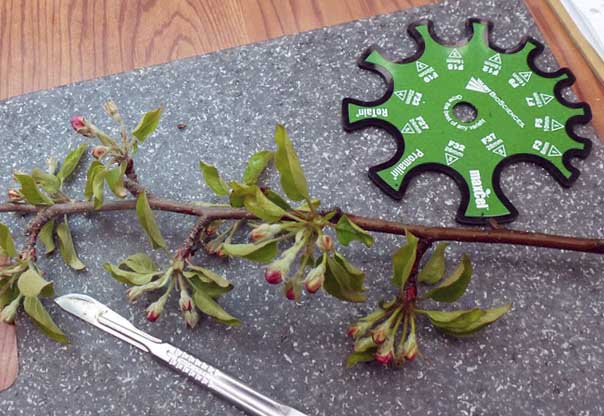
Bud damage assessment tools: razor blade, knife or scalpel and a limb-caliper tool, such as an Equilifruit. Dissect flowers lengthwise. (Courtesy Edwin Winzeler)
Eastern growers are assessing bud damage in their peach and apple blocks after an unseasonably warm March was followed by temperatures in the low to mid-20s in Pennsylvania and even colder weather in New York in early and mid-April.
Dr. Jim Schuup, a Penn State University associate professor of pomology, has adapted some methods growers can use to assess bud damage on peach and apple trees:
Peach bud assessment
Compare the number of live buds to the number a fruiting lateral should carry based on the target yield per acre:
1. To get a good estimate, examine about 150 to 200 flower buds per variety, per block.
2. Collect one strong fruiting lateral (pencil thick and 16 to 22 inches long) from each of two sides of five representative trees per block.
3. Bring the fruiting laterals into a heated building, place them in buckets of water, and allow them to warm up overnight.
4. Slice each bud open lengthwise with a knife, single-edged razor blade, or scalpel. Examine the pistil in the center of each flower and count the number of healthy ones.
5. Compare this number per fruiting lateral to the desired crop load. If, for example, there are 12 live flower buds on a fruiting lateral that should carry three peaches at harvest, then there are four times as many live flower buds as are required for a full crop.
Apple bud assessment
Compare the number of live buds to the target number for the branch diameter, using a limb-caliper disk such as the Equilifruit.
1. Collect one 3/8-inch to ½-inch diameter branch from each of two sides of five representative trees per block. Preferably, there should be no heading cuts on these branches, so this technique works best with tall spindle-trained trees.
2. Bring the branches into a heated building, place them in buckets of water and allow them to warm up overnight.
3. Slice each bud open lengthwise with a knife, single-edged razor blade or scalpel. Dissect the buds and count the number of king and side blooms with live ovules and styles.
4. Measure the diameter of the base of the branch with the disk to determine the number of fruit needed on that limb to set a full crop.
Compare the number of live buds to this number. If, for example, there are 20 live flower buds on a branch that should carry four apples at harvest, then there are five times as many live flower buds as are required to have a full crop.
For more information, consult Penn State University’s Tree Fruit Production News.
– by Dave Weinstock






Leave A Comment